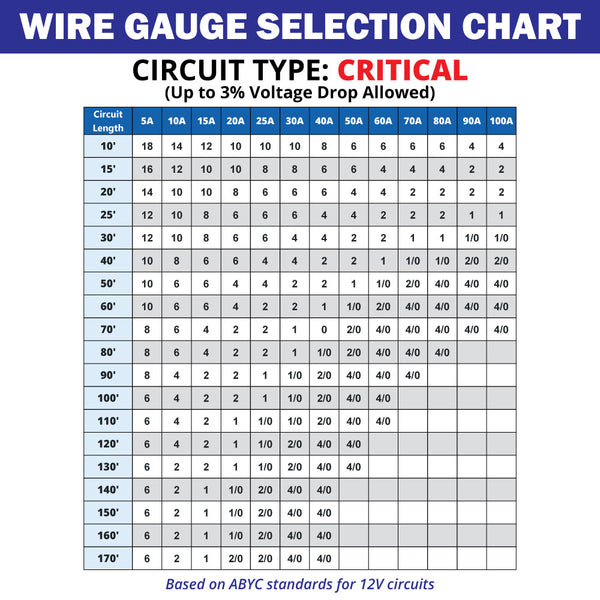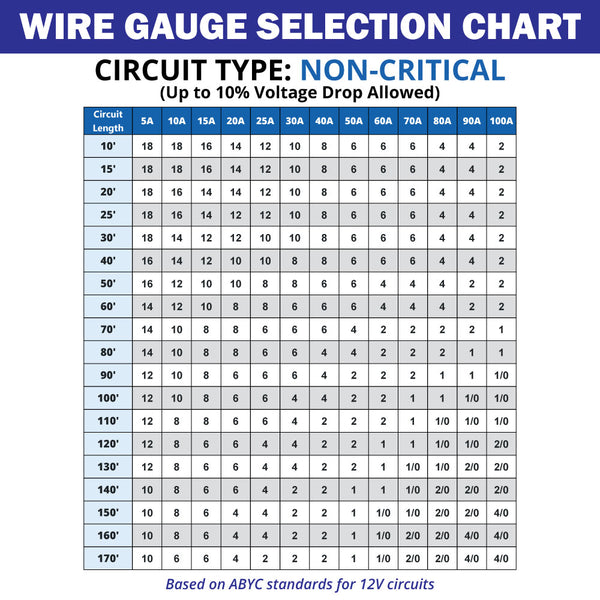Your One-Stop Shop for Wholesale Deals.
MARINE WIRE SIZE AND AMPACITY
MARINE WIRE SIZE AND AMPACITY
Even seasoned professionals may occasionally need to verify the appropriate wire gauge and ampacity (the maximum electrical current a conductor can handle) for a given marine DC load. We've established a straightforward method based on the following charts:
- Choose either the 10% or 3% voltage drop chart, depending on the nature of the load you're operating.
- Locate the load's current consumption on the chart's horizontal axis.
- Determine the circuit's length on the chart's vertical axis, keeping in mind that this length represents the round-trip distance from the electrical panel or battery to the load and back.
- The wire size indicated at the intersection of these values designates the appropriate wire gauge to use.
Of particular interest is the equation:
Voltage Drop = Current x Length x Wire Resistance (Ohms) per Foot
This straightforward equation enables you to calculate the voltage drop for a circuit of any length and any current flow, provided you know the wire's resistance.
Lastly, it's important to note that the ampacity of the wire restricts the use of very short wire lengths for high current flows, as depicted by the "flat tops" in the 10% chart sections.
These graphs assume:
Here are some key points to consider when working with Common Sense Marine Wire:
- 105°C Insulation Rating: Common Sense Marine Wire exclusively utilizes a 105°C insulation rating. Using insulation with lower temperature ratings is not recommended, as it cannot handle as much current safely.
- AWG Wire Sizes, Not SAE: Common Sense Marine Wire follows AWG wire sizes. It's important to note that SAE wire sizes are typically 6 to 12 percent smaller than AWG sizes. Consequently, SAE wires carry proportionally less current and exhibit greater resistance.
- No Wiring in Engine Spaces: Common Sense Marine Wire should not be routed through engine spaces. The maximum current capacity is reduced by 15 percent in engine spaces, which are assumed to be 20°C hotter than non-engine spaces (50°C as opposed to 30°C).
- Avoid Conductor Bundling: When bundling conductors, certain reductions in maximum amperage apply:
- If three conductors are bundled together, the maximum amperage should be reduced by 30 percent.
- For bundles containing 4 to 6 conductors, reduce the maximum amperage by 40 percent.
- If you have 7 to 24 conductors bundled together, the amperage should be reduced by 50 percent.
- These guidelines are crucial to ensure the safe and efficient operation of electrical systems using Common Sense Marine Wire in marine applications.
3% Voltage Drop
Use 3% voltage drop for critical applications affecting the safety of your boat and crew, such as running lights, blowers, electronics and panel board feeds. Remember that the Length is a round-trip distance. This table is for 12-Volt systems only.

10% Voltage Drop
Use 10% voltage drop for non-critical applications such as windlass, cabin lights, circuits other than running lights, electronics, or panel board feeds. Remember that the Length is a round-trip distance. This table is for 12-Volt systems only.



